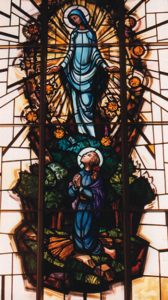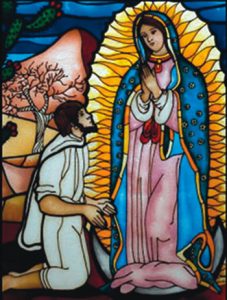Mary for Today Mary in the Year of Faith: Apparitions
Their Place in the Order of Things:
We need to remember the distinction in Christian theology between truths that are essential and primary (necessary for everyone) and truths that are accidental and secondary (real truth that takes its importance only in relationship to more essential truth). It can be true that the Blessed Virgin appeared at a given shrine, but that truth in no way has the same importance as does the central truth of the Incarnation. The truth of a Marian apparition is an accidental truth, not universally prescribed, but one that you can choose (on the basis of temperament, taste, background, culture, or time) either to respond to or not. There is a negotiability here, not about whether or not it is true, but about whether or not it is something to which we should attend.
Public and Private Revelation:
No one has the right to make public revelation out of private revelation. ‘Public’ revelation means those truths revealed to the inspired writers of the New Testament, and they have a definite completion date, by common theological consent, as the death of the last apostle. There was no new revelation to come, which means that revelations to individuals (popes or peasants) through apparitions of Christ (Sacred Heart or Divine Mercy) or the virgin, or saints, are purely private, with one valid purpose, to confirm the faith or spirituality of the individual/s involved or to confirm for the wider faithful that which is already the subject of ‘public’ revelation.
It is dangerous to assume that what happens in human history does not depend on responsible communitarian and social action and responsibility but upon miraculous intervention mediated by Mary, that salvation is her work. We have no right to make an ideology out of an apparition, nor use it to drown out other voices in the church, thus obliterating the very meaning of the word ‘catholic’. It is too easy to forfeit that the Holy Spirit speaks through more than one avenue in the church.
Some Apparitions:
Those that became famous and universally recognized are Guadalupe, Lourdes, La Salette, and Fatima. At Medjuggore (1981) Ivan Dragicevic reiterated the call to daily conversion with five weapons against Satan – prayer with the heart (such as the Rosary), fasting, reading the Bible, monthly confession and frequent Holy Communion. Turning to Mary for help and mercy has been a constant in the Church, particularly from the Middle Ages onwards as devotion to Mary became an even more integral part of Catholic life.
Popular religion is intensely human and emotionally charged, yet tends to be uncritical in accepting propositions of faith. The relationship between the believer and God or Mary tends to be a contractual one. In return for prayer, penance, or the fulfilment of a vow, God bestows favours. With the growing enthusiasm for Marian apparitions, it is important to link them with pilgrimages. Let us reflect what a comparatively recent phenomenon apparitions of Mary really are. For most of history pilgrimages were to tombs of saints; Thomas à Becket (12th century) being a particular favourite that led to the classic Canterbury Tales. We also have Bunyan’s allegory, ‘Pilgrim’s Progress.’ Pilgrimages represented a ‘tear in the veil’ separating heaven and earth. Often they became a means of nearing God on the part of those who were outside the official channels of access to the holy. Perhaps this still applies today for those who find access to the holy through apparitions rather than, unfortunately, through the liturgical channels from which they may feel alienated.
Caution is always called for; 210 apparitions were reported between 1928 and 1971, none of which received church recognition. Of those that had received earlier recognition care must be taken, even with them. La Salette has Mary saying that she gave the people six days to work and reserved the seventh for herself. That is the prerogative of God rather than Mary. Fatima’s vision of ‘souls falling into hell like leaves from the trees,’ can be taken as sending the greater mass of humanity to hell and taking away from the redeeming power of the Lord’s Passion, Death, and Resurrection. Such a pessimistic line may well owe more to the last Sunday’s homily heard by the children than a revelation from God via Mary. No study has ever been done on the social, cultural, and psychological conditioning of the visionaries.
Pilgrimages:
Sites of pilgrimages represent a ‘tear in the veil’ that separates heaven and earth. One purifies oneself by penance and travel. The pilgrim visits a holy site or shrine, where often magical beliefs abound: beliefs in relics, images, and the efficacy of water from sacred springs, but these only benefit the pilgrim who has had a conversion of heart. When a pilgrimage site becomes established, it operates like any social institution: liturgies and devotional services for an increasingly large group of pilgrim tourists. The literature surrounding Marian apparitions tends to be devotional and apologetic, defending and publicising what the authors believe to be appearances of Mary. Scholarly writings about apparitions are scarce, making the topic of apparitions a difficult one.
There is no definitive church teaching about what happens during an apparition. The church has always taught that the faithful are not required to believe in apparitions or their historicity; official church approval, which is limited to comparatively few apparitions, does not mean that the faithful are required to believe in the apparitions or in their historicity. They are private revelations that do not add to or embellish the deposit of faith. They are to be respected if they inspire people to deeper faith and consistent social action, to be judged by their fruits: love, justice, and peace.
“Even when a private revelation has spread to the entire world, as in the case of Our Lady of Lourdes, and has been recognised in the liturgical calendar, the Church does not make mandatory the acceptance either of the original story or of the particular forms of piety springing from it.” (US Catholic Bishops’ statement.)
Some apparitions are linked to a long tradition of healing shrines; others have been powerful messages of liberation for under-privileged and oppressed people. Guadalupe comes immediately to mind. Apparitions are usually experienced by the poor, mostly poor women, and the young, and the theophanies are described in great detail. Could the appearances to women of all ages be an expression of a voice or voices not being heard by the institutional church but forcing its way through the charismatic dimension of the church? Apparitions are expressions of the charismatic element in the church; it is this feature that tends to cause orthodox religion to be ambivalent about them.
Constant features in apparitions that keep appearing are Mary as healer and restorer of faith; the claim of miraculous cures at Marian shrines still persists, especially at Lourdes. Another constant is Mary as an intercessor between heaven and earth, pleading with God on our behalf, influencing God’s judgments. Last century at Fatima she became instrumental in Pius XII’s criticism of communism and the prayers for the conversion of Russia. Yet similar prayers were lacking against Nazism, and are lacking against the ravages of unbridled capitalism, recent target of Pope Francis.
Resource:
Coyle, Kathleen (1998), Mary in the Christian Tradition, Divine Word:Manila.



 Entries(RSS)
Entries(RSS)